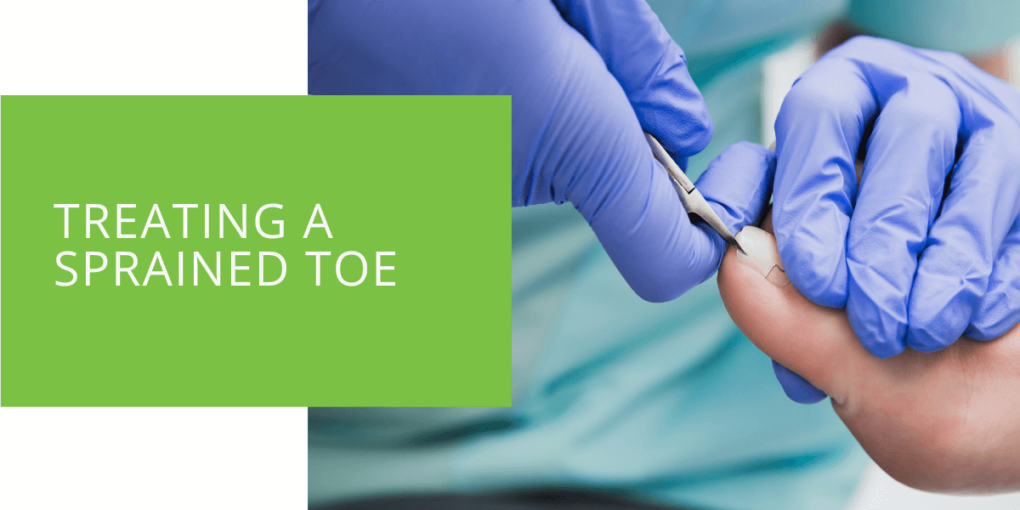Treating a Sprained Toe: A Step-by-Step Guide
Sprained toes can be painful and inconvenient, but you can speed up the healing process with the proper treatment and minimize discomfort. In this comprehensive guide by podiatrists, we'll walk you through the essential steps for treating a sprained toe. Whether you've injured your big toe or any other toe, our expert advice will help you get back on your feet.
Key Takeaways
- Remember the R.I.C.E method - Rest, Ice, Compression, and Elevation - to reduce pain and swelling when you sprain your toe.
- Immobilization, pain relief, physical therapy, and specialized care are essential in effectively treating sprained toes.
- Choosing the right footwear, being cautious of your surroundings, and regular exercise can help prevent future toe sprains.
Immediate First Aid
When you first sprain your toe, taking immediate action to reduce pain and swelling is crucial. Here's what you should do:
- Rest: Avoid putting weight on the injured toe. Use crutches if necessary to minimize pressure.
- Ice: Apply an ice pack wrapped in a cloth to the affected area for 15-20 minutes every hour to reduce swelling.
- Compression: Consider using a compression bandage, but make sure it's not too tight to avoid cutting off circulation.
- Elevation: Keep your foot above your heart's level whenever possible. This helps reduce swelling.
These initial steps, collectively known as the R.I.C.E. method, are crucial in the early stages of treatment. They can significantly alleviate pain and promote healing.
Medications and Pain Relief
If you're experiencing severe pain and swelling, over-the-counter pain relievers like ibuprofen or acetaminophen can help. Follow the recommended dosage instructions on the label. In some cases, a podiatrist may prescribe stronger medications to manage pain effectively. Consult with a healthcare professional for guidance.
Immobilization and Support
To protect your injured toe and prevent further damage, consider immobilization techniques:
- Splints: Toe splints can help keep the toe stable, aiding the healing process.
- Buddy Taping involves taping the injured toe to an adjacent healthy toe. Ensure that the taping is not too tight, which could impair circulation.
- Protective Boot or Brace: Sometimes, a podiatrist may recommend a specialized boot or brace to provide extra support.

Physical Therapy
Physical therapy plays a crucial role in restoring the function and strength of your injured toe. A podiatrist may recommend specific exercises and stretches designed to improve the toe's range of motion and flexibility. Following these exercises regularly can expedite your recovery.
Managing Big Toe Sprains
A sprained big toe can be particularly challenging due to its crucial role in balance and mobility. In addition to the general treatment steps mentioned earlier, you may need to be more cautious. If there's severe pain or you suspect a broken toe, consult a podiatrist for a thorough evaluation, which may include X-rays to rule out fractures.
Treating Turf Toe
Turf toe is a specific type of toe sprain common among athletes. It usually affects the big toe and can be quite painful. Treatment for turf toe includes rest, ice, and avoiding activities that stress the joint. A podiatrist may recommend a specialized brace or orthotic devices to provide additional support if the injury is severe.
Expected Healing Time
The duration it takes for a sprained toe to heal varies from person to person and depends on factors such as the severity of the sprain and how well you follow the treatment plan. On average, mild to moderate toe sprains can take several weeks to heal completely. However, it's essential to continue home care and follow up with a podiatrist as needed.
Preventing Future Sprains
To avoid future toe sprains, take these precautions:
- Appropriate Footwear: Choose shoes that provide good support and fit properly.
- Be Mindful of Your Surroundings: Watch out for hazards that could cause you to stub your toe.
- Regular Exercise: Strengthening the muscles around your toes can help prevent future injuries.
Conclusion
Treating a sprained toe requires a combination of immediate first aid, proper immobilization, physical therapy, and patience. While you can manage some aspects of treatment at home, consulting with a podiatrist is essential for a thorough assessment, especially if you suspect a severe injury or fracture. At ePodiatrists, we are here to guide you through the recovery process and provide expert care.
Don't let a sprained toe hold you back. If you're experiencing pain and swelling, take action today and schedule an appointment with us. Our team of experienced podiatrists will ensure you receive the best care tailored to your specific needs. Get back on your feet and back to your life - contact ePodiatrists now for expert assistance.

